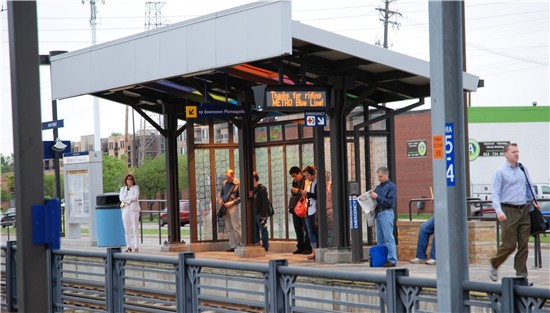 Are people who live near the METRO Blue Line happier than those who live in areas without such ready access to light rail transit?
Are people who live near the METRO Blue Line happier than those who live in areas without such ready access to light rail transit?
In a word, yes.
New research by University of Minnesota associate professor Jason Cao shows residents living within a half-mile of the Blue Line are more satisfied with their travel than those who live in corridors without LRT. Hiawatha corridor residents were also found to have a higher quality of life in the research.
Published earlier this year, the findings are based on a 2011 survey of around 1,300 residents living between the Blue Line’s Lake Street and 50th Street stations, the most residential section of the 12-mile Blue Line. People living on Minneapolis’s Nicollet and Bloomington avenues, in Coon Rapids and in Burnsville were surveyed for comparison purposes.
Cao said accessibility to “activity destinations” like downtown Minneapolis, the Minneapolis-St. Paul International Airport and Mall of America is one of the primary reasons residents derive happiness from the Blue Line. The quality of the travel itself also plays a role.
“This is about the positivity of travel – not just using the rail to get to a destination, but enjoying the travel itself,” Cao said. “Passengers can read, listen to music and relax instead of driving in traffic and congestion which contributes to their quality of life.”
Before the study, Cao said he suspected residents along the Blue Line would be more contented than those with less transit access. But aside from his recent research, there had been little data to support the claim.
Now that he’s established an association, Cao hopes to continue his research on the Blue Line and learn more about the connection between frequency of transit use and quality of life. He’d also like to extend his work to include the METRO Green Line, opening next year.
Though Cao maintains rail’s main purposes are reducing the growth of congestion and inspiring economic development, he said the happiness factor is a positive marginal benefit that shouldn’t be discounted.
“If we have good transit attributes, no matter if it's rail or bus, I think we’re going to see an increase in satisfaction with travel for those people and then indirectly a boost in quality of life,” he said.
> Atlantic Cities: Living Near Good Transit May Make You Happier
> Urban Land: Twin Cities' Residents Near Transit Found to Be Happier
> Study: Transit boosts economy
> U of M: Center for Transportation Studies